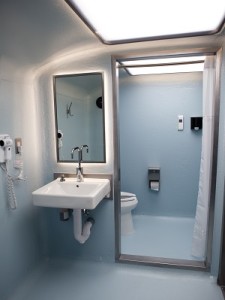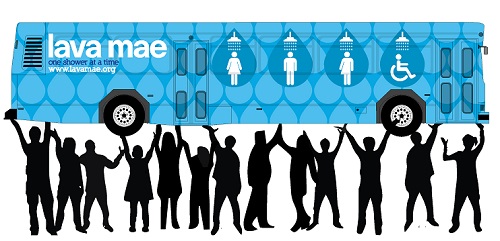
UPDATE: 6/2/17: Doniece Sandoval named a 2017 CNN Hero of the Year! Congrats, Doniece!
UDPATE: 2/9/15: Lava Mae Showered with Accolades and Opportunities for Growth
UPDATE 10/3/14: Doniece is working on getting a second Lava Mae bus on the road. She says the impact with the first bus has been amazing. They’ve launched an IndieGoGo campaign you can check out here.
By Patricia Caso/August 3, 2014
Photos: Courtesy Lava Mae
TWITTER: @lavamae
WEBSITE: Lava Mae
Homelessness is a major concern and complex issue in a growing number of cities around the world. Like many I have donated clothes and given money to agencies and organizations. San Francisco’s Doniece Sandoval went much further and came up with a way to bring dignity to the homeless, “one shower at a time.”
“I thought if you can put gourmet food on wheels and take it anywhere, why not showers and toilets? So, the idea for Lava Mae was born!” Doniece Sandoval
She’s done it by retrofitting a bus and naming it Lava Mae, a twist on Spanish for “wash me.” Doniece does not purport to end homelessness, but rather to make a small but significant difference in the lives of the overlooked.
I was inspired after speaking with Doniece to find out about her motivation and how Lava Mae came to be. I think you will be too!…
EYE: How did this innovative idea come to you?
DONIECE: We moved from New York to San Francisco in 2002. With my adopted 3-month-old daughter, I would stroll the neighborhood and got to know many people. After the downturn, our neighborhood became trendy; gentrification set in. Too many of our neighbors moved from their homes, to their cars, to the streets.
It’s been heartbreaking. We felt powerless to help, and I wanted to figure out some way to make a difference. I could not put my head around how you end homelessness. It just seemed so complex.
One day I was walking in another neighborhood and I passed a young woman sitting on the sidewalk who was crying, filthy and muttering to herself that she would never be clean.
EYE: Was she the reason you decided to take action?
DOENICE: Yes! I knew she meant a lot of things by those words that I would never understand. I wondered what were her chances of getting physically clean? That evening I did some research. There are over 7,000 homeless in the city. About half of those people live on the streets near shelters that don’t have showers.
“So, upwards of 3500 people on the streets have to make do with the seven drop-in centers that have showers. That’s 14 shower stalls for 3500 people! I thought that was utterly criminal.”
At the same time the whole mobile food craze was going strong. I thought if you can put gourmet food on wheels and take it anywhere why not showers and toilets? So, the idea for Lava Mae was born!
EYE: Who was your first call?
DONIECE: I called Jennifer Friedenbach who is with the Coalition on Homelessness in San Francisco, one of the oldest and most venerable advocacy groups for the homeless in the City. She would be my litmus test.
I heard she’s tough, and she’s smart. I was pretty terrified. I thought her attitude might be “Who ARE you? You’ve never worked with the homeless.” Not that at all.
She started pulling out information for me–information on public health, the impact of not having access to showers, the number of bug bite visits to SF General, etc. She said, “Yes, if you can do this, GO! This is awesome!”

EYE: I understand that you went without a shower for a full week so that you could experience what many homeless go through?
DONIECE: My friends were teasing me that I was doing a publicity stunt because my background is in marketing and public relations. When you are in the middle of a crowd-funding campaign, you have to do things that drive or capture people’s attention.
But the lion’s share of that was the idea of stepping into people’s shoes and struggling to stay clean for a week. Of course, I had a completely illusory sense of homelessness, coming home every night and sleeping in my warm comfortable bed.
I am a bit of a clean freak, so it was a challenge for me not to take a bath, step in a shower and fully wipe the day’s grime off. I tried to pop into the bathroom in my office or use the wipes in the bathroom in the local grocery store to clean myself off.
But it left me with the impression of just spreading the grime around, rather than actually cleaning myself up. I was certainly not feeling good about myself.
EYE: Were there any surprises to this experience?
DONIECE: I think one of the things that surprised me about the people who knew what I was doing was that they would say,” Oh yeah, you’re not showering! How’s that going? You look great! You don’t look dirty at all. You look perfectly clean.”
What hit me was that we have a really strong perception that stems from the superficial about what people are doing, or what state they are in, based on how they look. It’s not always accurate. But on Day Six, I walked into the kitchen and my 6-year-old daughter said, “What smells?” I knew it must be me.
When I finally got to shower, about a minute into the water hitting me, I started to cry. I realized that part of me had disconnected and shut down. Being in a shower felt warm, protective and restorative. It was a very emotional experience.

EYE: This is a complex project, two years in development. Were you prepared to navigate all the issues?
DONIECE: The only experience I had with the homeless was volunteering with different organizations throughout the years. I don’t think I quite knew what I was undertaking. What is that saying, “What you don’t know might be better for you? If you know everything, you might not do it.”
I started by knocking on doors of non-profits to find out if this was even a reasonable idea. I thought they would say one of two things: this is crazy and I should just go away, or, this is so brilliant, we want to do this! I don’t think I expected that I would be the person executing it as well.
“What I did find was non-profits who said you are crazy and we want you to do this and we’ll help however we can. So I knew if it were going to happen, then it had to be up to me.”
EYE: How do people sign up and what can they expect?
DONIECE: Our partner non-profit drop-in centers get the word out and people sign up for Lava Mae at their site. That way people don’t clog up the sidewalk or waste their own time waiting in line.
We get them when it’s their shower time, orient them, get their towels and toiletries for a 20 minute appointment and 10 minutes of hot water for their showers. So far everyone has been very respectful and we tweak the time when someone is disabled, taking extra time getting on and off the bus and in and out of the shower.
We are starting slowly to do things really well. Thirty showers a day is realistic in a five-hour period.

EYE: Have you found any resistance in the neighborhoods?
DONIECE: Sadly, a little bit. However, the majority of the people in this Mission District are very supportive. They see the benefits for all the people involved and are happy to see us there.
EYE: I read that each bus cost $75,000 to fit Lava Mae’s needs. How did you come up with the money? Can you sustain this with all the maintenance, etc.?
DONIECE: We launched our effort for Lava Mae on a crowd-funding site, Indiegogo, raising $58,000.The rest came through our website, all from just regular people who thought this was a really great idea.
We still receive money from small family foundations and individuals like David Bronner of Dr. Bronner Soaps who gave us $50,000. It is my sense that from the support we are continuing to get, plus grants like $100,000 from Google, this idea is very sustainable.
Since we get no financial government support, we are also in the process of creating a revenue stream for ourselves to keep this a private project.
EYE: What have you learned from your initial participants?
DONIECE: We showered 20 people in our test run. Silas was our first, who is from the South, a charmer; he loves to have his picture taken. He almost kissed our feet because he had this opportunity.
In getting to know him, one learns that he meanders around the city because he was cited by police for sleeping on a bench. Silas is always looking for a soup kitchen for lunch. He relates this without pity or bitterness.
“Silas is working to stay clean and loves the Opera, even managing to get tickets. You have got to love him. There are no words for what it means to connect with a human being in this way and feel you are just a small part of making his and others’ lives a little bit better.”
EYE: What are some of the challenging issues you’ve had to face?
DONIECE: One of the scariest times was finding the company that would retrofit the bus. To no avail, I called companies all around the country who do promotional tours, rock stars, etc. Ultimately, we found Airco, a local company that basically builds the guts for skyscrapers, who were more than thrilled to accept the challenge.
Another was to include the wheelchair radius in the bathroom floorplan, which is completely ADA compliant. We need to serve the disabled, which is 46% of the homeless population. Then, there were little things like the water from the showerhead that splashed so the toilet paper roll got completely saturated.
We had to redo that. You don’t know until you try it out! When we did our test run, we drove up to our location, pulled out our hose and it was 10 feet short of the fire hydrant! What’s the saying? What doesn’t kill you…?” We ARE strong now!

EYE: How do you reflect on this whole project so far?
DONIECE. I am driven to be creative and productive. Until Lava Mae, I was like Lucy in the Peanuts strip. I’d love to have a pop-up booth and have people pay me to just come up with good ideas, because I am good at that.
In my time here in Silicon Valley where creativity abounds, I’ve learned ideas are cheap. A lot of people have great ideas. Executing them is, at the end of the day, what really matters.
It’s hard. It’s a lot of work. On a broader level, we need to change non-profits as they are. There needs to be some blending of the private sector mentality, the start-up engine kind of mentality, with non-profits so that non-profits can be better, stronger and more resilient.
EYE: How have you gotten through the tough challenges without walking away?
DONIECE: Until I started to get a staff, it was my husband who supported this project since Day One. He believed in me and my ability to pull people together to make this happen.
Second, I may have had the idea and gotten the ball rolling, but so many people have come together. I really feel like we’ve built a village to make Lava Mae happen. It didn’t happen just because of me. That has sustained me over and over again.
EYE: What can others learn from you in executing such a meaningful project?
DONIECE: I’m just one example of the many out there that can make a difference and it doesn’t have to be on this level of big and elaborate.
If you feel this calling to help out in your community, don’t let that pass you by. Life is too short. It will be something you are proud of and that made your life matter.
EYE: We hope that Lava Mae continues to grow and expand to many cities. As you believe, access to showers and toilets should not be a luxury and is a basic human right. Thank you, Doniece!
###





Leave a Reply